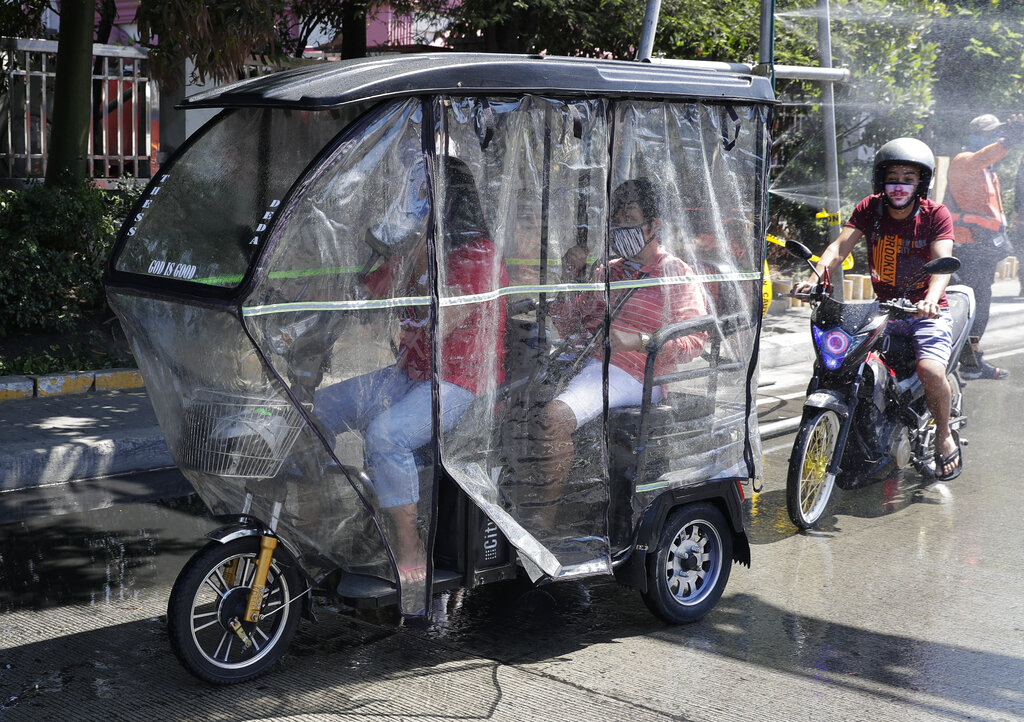
Image credits: AP/Aaron Favila
OVER 19 million women aged 15 and over are not part of the labor force based on the latest results from the Labor Force Survey (LFS) conducted by the Philippine Statistics Authority (PSA).
On Tuesday, the PSA reported that the number of jobless Filipinos reached 4 million in January and the underemployed, 6.6 million.
Data showed that while there are a total of 37.2 million women in the 15 years old and over age group, only 17.455 million are in the labor force in January.
“The top five reasons why women opted to be out of the labor force in January 2021 based on the LFS were schooling (especially for ages 15 to 18 years old); household family duties (especially for ages 25 to 44 years old),” PSA Assistant National Statistician Wilma Guillen said.
“[Other reasons include the] ECQ/lockdown/Covid-19 pandemic; temporary illness/disability; [and] awaiting results of previous job application,” she added.
Guillen said the number of women who are not part of the labor force in January—which reached 19.745 million—was higher than the 18.708 million in January 2020.
This meant there were 1.037 million more women who dropped out of the labor force in January 2021 compared to January 2020.
In terms of the labor force participation rate (LFPR), more men were in the labor force compared to women in January 2021. The LFPR among men was at 73.9 percent while for women it is at 46.9 percent in January 2021.
The employment rate of men was also slightly higher at 91.3 percent; women registered an employment rate of 91.2 percent in January 2021.
The unemployment rate among women, however, was higher at 8.8 percent in January 2021 compared to men, 8.7 percent.
In terms of underemployment, nonetheless, there were more men who were underemployed at 17.6 percent, significantly higher than the 13.4 percent posted by women in January 2021.
“The crisis and lockdowns really hit women hard, particularly among mothers and single-mother breadwinners. Some of the activities that they did and are doing to cope with the crisis and keep the family intact or surviving are usually not reflected in the PSA data, such as networking to get social amelioration,” former dean of the School of Labor and Industrial Relations (Solair) Rene E. Ofreneo told the BusinessMirror in an e-mail.
Ofreneo noted that while there was an increase in the number of women who joined the labor force in January 2021 compared to October 2020, this is not something to celebrate.
Based on PSA data, in January 2021, there were 17.455 million women in the labor force, 851,000 more than the 16.604 million in the labor force in October 2020.
On an annual basis, Ofreneo added, 107,000 women dropped out of the labor force in January 2021 compared to January 2020.
“The faster rate from October 2020 to January 2021 means catch-up. The latter part of the year is also Christmas season (think of work in gift-giving industry, etc.),” Ofreneo said.
“The severe loss of jobs for women during the harsh lockdowns from March to the third quarter of 2020 naturally affected women in the large services sector,” he added.
Questionable data
However, Ofreneo said the latest employment data is also not encouraging. Given that the unemployment rate for January 2021 is 8.7 percent, around 4 million still did not have jobs.
Ofreneo said with the figure of those not in the labor force increasing by 1.6 million and the “natural labor force increase” year on year, the country’s true unemployment rate could reach at least 10 percent.
The Nagkaisa labor coalition estimated that this true unemployment rate was at 10.3 percent, which means that some 4.5 million workers were rendered jobless in 2020, the highest in 15 years.
The country’s biggest labor coalition renewed its call for the government to make public employment a recovery strategy in the face of a lingering job crisis.
Nagkaisa labor coalition said it is only through employment that household income and the economy can be sustained in the short and longer term as the rollout of Covid-19 vaccine and reviving the private-led economy is taking longer than expected.
Under its proposed Unemployment Support and Wage Assistance Guarantee (USWAG) agenda that it has already submitted before the labor department and the National Tripartite Industrial Council (NTIPC), Nagkaisa called for public employment programs (PEPs) on mounting social tasks in the health sector, the environment, food security, and the social housing sector, among others.
“With the snail-paced rollout of vaccination and the threat of Covid-19 surges which continues to dampen the market, expecting the private sector to solely address the jobs crisis is not an option. It is time for the government to be the biggest employer on social tasks that need to be done and levelled up, with or without the pandemic,” said Nagkaisa chairman Sonny Matula.
Defend Jobs Philippines also questioned the recently released LFS data by the PSA, insisting that the true unemployment rate of the country was at 10.3 percent.
The labor group cited various independent survey firms which revealed “comparably far” data on unemployment in contrast with the PSA.
Defend Jobs Philippines Spokesperson Christian Lloyd Magsoy said that a Social Weather Stations Inc. (SWS) survey revealed a 45.5-percent unemployment figure, which is equivalent to 27.3 million unemployed Filipinos due to the pandemic.
According to SWS, the jump in adult joblessness in July 2020 was a 28-point increase from the 17.5 percent in December 2019 and a record-high increase since 34.4 percent in March 2012.
“While we are one with the PSA’s analysis that last year’s joblessness figures marked the highest recorded annual unemployment rate in history since 2005, we express uncertainty over the concrete and actual figures of this labor force survey,” Magsoy said.
Signs of growth
In terms of overall employment, the President’s economic team said in a joint statement that the unemployment rate averaging 8.7 percent in January is a sign that the economy is slowly recovering.
The economic team noted that between October 2020 and January 2021, a total of 1.4 million jobs were created. This increased the proportion of the working-age population to 60.5 percent in January 2021 from 58.7 percent in October 2020.
They added that the biggest improvement was observed in the National Capital Region (NCR) or Metro Manila, where 269,000 jobs were created between October 2020 and January 2021.
Outside NCR, the picture was not as rosy. The economic team said unemployment increased to 8.7 percent and underemployment increased to 17.1 percent in the same period.
The President’s economic team traced this to weather disturbances and flooding, the African Swine Fever that badly affected livestock production, and mobility restrictions.
“While the data show that across sectors, we are gradually getting back the jobs we lost due to the pandemic, the smaller progress in the past quarter suggests that we still need to address the remaining restrictions before the economy can get closer to normal,” the economic team said.
To accelerate economic growth and job creation this year, the National Economic and Development Authority (Neda), citing the economic managers, said a three-pronged strategy is needed.
The first is to safely reopen the economy while maintaining health protocols; implement the recovery package; and ensure the timely implementation of the vaccine program to cover the entire adult population.
The economic managers emphasized that full and fast implementation of the recovery package would underpin economic growth this year and onwards.
The higher stimulus through the Bayanihan II, the 2020 budget extension, the 2021 budget, as well as the swift enactment or implementation of key legislations, such as the Financial Institutions Strategic Transfer (FIST) Act, the Corporate Recovery and Tax Incentives for Enterprises (CREATE) Act, and the Government Financial Institutions Unified Initiative to Distressed Enterprises for Economic Recovery (GUIDE) Act, are all crucial.
With the employment numbers and the call of the economic team, Labor and Employment Secretary Silvestre Bello III said the country has a better chance of seeing improvements in the labor situation in the country.
“Improvement in the employment situation shows that businesses and workers are starting to regain confidence with the safe reopening of the economy,” Bello said.
“We expect a better and more improved employment performance in the coming months with the vaccine being made available and more Filipinos under the priority categories getting inoculated,” he added.
Image credits: AP/Aaron FavilaRead full article on BusinessMirror

